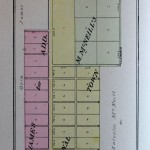In the summer of 1903 Henry Hafer sank a shaft mine in the northeast quarter of section 36 of Blairsville Township. Most of the men working in sinking the mine and erecting the buildings around it came from Herrin of Carterville. The Coal Belt Electric Railroad Herrin to Carterville branch passed the sight. The trolley company established a station where the half section road crossed the railroad, on the south section line. The station was named Hafer.
Malcom McNeil, who owned the land on the cast side of the half section road, just north of the railroad, plotted off 29 lots and named the plot Malcomville. Jesse McNeil of Herrin bought 8 lots at the north end of the plat and erected 8 houses, as a rent investment. A.K. Ellis of Herrin bought six lots and erected 6 houses. With 14 houses up the boom began. Orin Jones owned the farmland across the road from Malcomville. He plotted 12 lots and tailed it Orin Jones’ first addition to Malcomville. Others bought small plots of land around the lots and between 65 and 70 houses were built. Malcomville had a population of about four hundred.
Hafer Mine worked more than a thousand men when it was at its height of production. These men dug coal by hand, a process known as working on the solid.
The mine was located halfway between Herrin and Carterville. A special car from each town came to the mine. The miners wore their dirty pit clothes when they rode these cars. They were too dirty for any others to ride.
The depot at Malcomville was a lean-to type shed with a bench against the back wall. This was the only shelter from the rain and sun. There was no heat in winter and air conditioning was unknown.
Soon after Hafer Mine began hoisting coal it was given the name Punkin Ridge.
Malcomville grew rapidly, for in those days it was desirable for one to live near his work. Henry Hafer did not put up a company store. Winnett Mason erected a small building and opened a grocery store. He sold lard oil tor the miner’s lamps. Later a paraffin compound known as “sunshine” replaced the lard oil in the same lamps. Then still later carbide lamps were introduced. Carbide gave by far the better light. Mason did a big business in his little store. Malcomville was a boom town during the First World War years.
Hafer Southern Baptist Church was organized about the time the village came into existence. The traditional rough hard miners were in the minority in all the coal towns. Many miners were devout Christians and Hafer Baptist Church prospered.
Following the Herrin Mine Riot in 1922, Williamson County Coal was boycotted nationally. This was especially true of Herrin mines and Hafer was considered a Herrin mine. As a result Hafer Mine was closed in 1925. The people sought employment elsewhere. Even then, highways were not plentiful and it was still desirable that a man live near his work. House after house was vacated and began to deteriorate. The houses were torn down or they burned. The Coal Belt Electric Line was terminated and the track taken up.
Today Malcomville has fifteen houses along the half section road. The population is 40. There are no business establishments in the hamlet. The mine gob dump can be seen high to the north of the village. Around it one can see the concrete foundations of the mine structures. The prosperous days are gone.
(Ghost Towns of Southern Illinois, by Glenn J. Sneed, published 1977)

